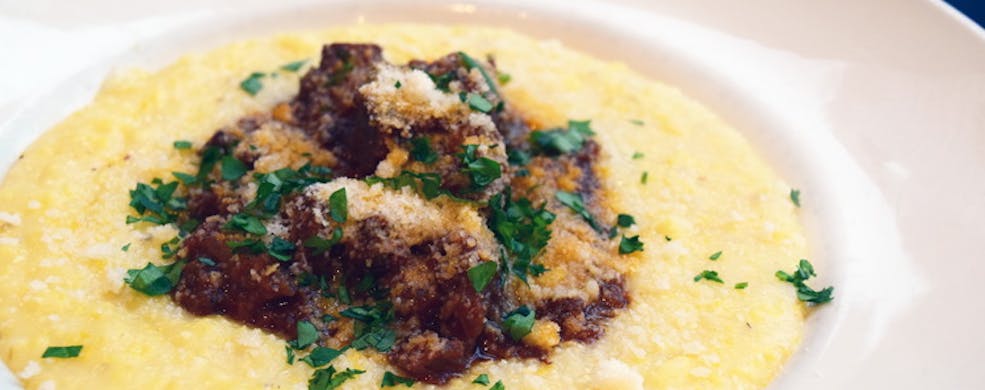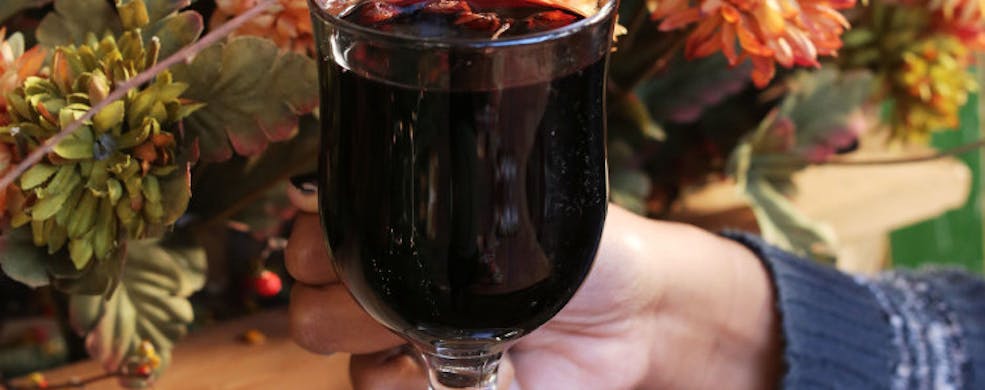In Italy, eating seasonally is a way of life. It's also one of the secrets to Italian cuisine. After all, when you eat seasonally, it means you're eating ingredients when they are fresh and at the height of their flavor!
So what do Italians eat in the winter? While you won't find any fresh tomato bruschetta, you can expect to indulge in many other delicious dishes. Explore our guide below to learn about 12 things Italians eat and drink in the winter.

1. POLENTA
A staple of northern Italy, polenta is made of ground cornmeal. It can be boiled and served as a hot porridge with cheese, braised beef ragù, or stews. Another method for serving polenta is to let it cool after boiling, then bake it, grill it, or fry it. Polenta is a staple on any baita, or ski lodge, menu as well – the perfect stick-to-your-ribs meal after a long day on the slopes.
2. CANEDERLI
These toothsome bread dumplings are a popular first course in Trentino Alto-Adige, a region found in northeast Italy. They are made by soaking bread in fresh milk, then mixing it together with eggs, local cheese, and sometimes speck, a half-smoked half-cured ham. The mixture is then rolled into ping pong-sized balls and served with melted butter or broth. Get a taste of these comforting dumplings with our recipe for Leek and Fontal Cheese Canederli.
3. RIBOLLITA
A classic dish of Toscana, ribollita is a hearty winter vegetable soup. It's the perfect example of cucina povera – poor cooking – as it's chock-full of winter vegetables like kale, potatoes, and carrots and thickened by leftover day-old bread. Get the recipe.
4. ALPINE SALUMI & FORMAGGI
The best way to warm up on a chilly day? Take a cue from this Italian winter tradition: make a cozy fire, then set up the ultimate antipasto platter packed with firm Alpine cheeses, smoky Speck IGP, and sweet mountain honey to match. In the mood for something even more comforting? Feast on melted favorites like raclette (we like to think of it as fondue's showier cousin), or add a topping of melted Fontina DOP to seasonal produce.



5. BLACK WINTER TRUFFLES
Found and foraged in the hills of Umbria, black winter truffles grow wild near the roots of hazelnut and oak trees. Only in season for a few months a year, this variety of truffle is known for its earthy, robust flavor. In Umbria, this truffle is typically enjoyed as part of salsa alla spoletina, made with minced truffle, olive oil, garlic, and salt and served with silky egg tagliatelle.
6. CASSOEULA
A specialty from Italy's northern Lombardia, this elaborate dish consists of savoy cabbage and various types of pork. Legend has it that St. Anthony Abbot, the founder of Christian monasticism who was known as the protector of domestic animals, declared January 17 as the last day to slaughter pigs. On this day, cooks would use all of the parts of the pig ready that couldn't be preserved immediately after slaughter to make a stew called cassoeula. The better cuts of the meat were salted and hung to cure to improve their flavor. Nowadays, it's tradition to enjoy cassoeula – usually with polenta and a glass of red wine – starting after the first frost of the season when cabbage is softer and tastier.
7. PASTA IN BRODO
Serving pasta in broth is a popular way to enjoy pasta in the wintertime, especially in Italy's central and northern regions where the weather can chilling to the bones. In Emilia-Romagna, tortellini in brodo, tiny pork and cheese-stuffed parcels, are king, while in Piemonte, the veal-stuffed agnolotti del plin are served in a rich Parmigiano broth. Sometimes the broth is made from boiled meats, which are then chopped up and stuffed into the pasta in order to avoid waste.
Try our recipe for Agnolotti del Plin in Brodo, which uses the leftover Parmigiano Reggiano rinds to make a rich, cheesy broth. Sustainable, warming, and delicious!
8. RISOTTO
There's nothing quite like a steaming pot of risotto to warm up your kitchen on a cold winter's day! There are three basic ingredients to risotto: rich broth, short-grain Italian rice (which has a higher starch content then long-rain rice), and a splash of dry wine. The broth is slowly added to the rice and stirred constantly until creamy and al dente. During the cooking process, other flavorings can be added, too, such as porcini mushrooms, saffron, or seafood!


9. RADICCHIO
If you've ever been fortunate to enjoy a salad peppered with lovely pink leaves, you're likely enjoying radicchio (rah-dee-key-oh), Italian chicories known for their delightfully bitter taste and incredible array of shapes and colors. From the marbled leaves of the Castelfranco variety to the fuchsia tendrils of the Tardivo, most Italian radicchio hails from the Veneto region, where this vegetable and its enchanting hues are a well-known specialty. Swap some radicchio into your next winter salad for a meal that is as pleasing to the eye as it is to the palette.
10. VIN BRULÈ
Vin Brulè is Italy's version of mulled wine. Made by infusing a fruity red wine with spices like anise, cloves, and cinnamon and citrus zest, Vin Brulè is often served at Christmas markets in November and December – although we think it's great all winter long!
11. CIOCCOLATA CALDA
Unlike American hot chocolate which usually contains more milk than cocoa, Italian hot chocolate, known as cioccolata calda, has more cocoa than milk giving it a dense, thick consistency. Swoon. It can be enjoyed on its own or topped with whipped cream. You can try it your local Eataly, or make it at home with our recipe for traditional Italian hot chocolate.
12. ARANCE
Did you know that oranges are one of Italy's greatest fruits? Grown predominantly in Sicilia, blood oranges known as Conca d'Oro, are at their peak in January and February. Other citrus fruits like clementines and mandarins, are also popular during this time and many Italians will order a spremuta d'arancia, or freshly squeezed orange juice, from their local bar.


Find all of these items and more at your local Eataly or shop our selection of winter ingredients online to bring a taste of Italian winter to your table!
